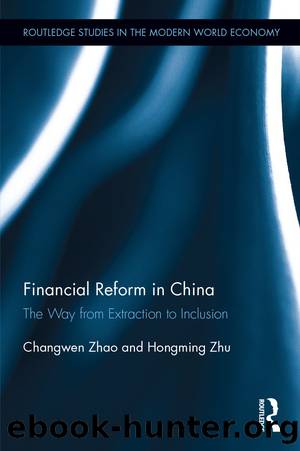Financial Reform in China by Zhao Changwen;Zhu Hongming; & Hongming Zhu

Author:Zhao, Changwen;Zhu, Hongming; & Hongming Zhu
Language: eng
Format: epub
Publisher: Taylor & Francis Group
Published: 2017-06-16T00:00:00+00:00
Restrictions on access and asset substitution
Two other policies under a financial restraint system are as supportive to the interest margin protection policy: restrictions on access and asset substitution. The interest margin protection policy cannot be formulated without two restrictions. Fiercer competition inside the financial system, inside the banking sector or between banks and the capital market will erode the interest margin and make it hard to maintain a high interest margin. Restrictions on access and asset substitution help with the implementation of the interest margin protection policy by restricting competition or reducing the intensity of competition.
For over a decade, China has imposed strict restriction on access to the banking sector, due to lack of a smooth withdrawal mechanism and the need to maintain financial stability. The China Minsheng Bank was the only depository financial institution established in the period from 1996 to 2013. The number of financial institutions in Chinaâs banking sector keeps declining due to the reform of rural credit cooperatives. At the end of 2006, there were 19,797 financial institutions with legal status in the banking sector, including 19,348 rural credit cooperatives; and at the end of 2013, these two figures were down to 3,949 financial institutions with legal status and 1,803 rural credit cooperatives. According to the financial restraint theory, such strict access control helps prevent excessive competition inside the banking sector and maintains the banksâ ârentâ or âfranchise valueâ endowed by the interest margin protection policy.
China has formulated no policies concerning asset substitution restriction. Instead, China developed the multi-layer capital market and enhanced the proportion of direct financing as the main features of its financial policy. Then, does that deny actual existence of asset substitution restriction in China?
The answer is no. As a matter of fact, excessive expansion of the banking sector squeezes development space for other financial sectors in the financial system. Considering the stage of economic development that China was in and its special economic and financial system, Chinaâs had a typical bank-dominated financial system before the financial restraint policy was adopted. Banks had the upper hand, compared with the financial market. Against such a backdrop, interest margin protection, as a strong stimulus to the banking sector, further reinforces the advantageous position of banks, and plays the same role as the asset substitution restriction. Laggard development of non-bank financial institutions restricts asset substitution. Therefore, as far as the effect of the previous round of financial reform is concerned, despite constant financial deepening, residents have few options for financial investment other than deposit and investment products provided by banks (Table 4.5). That means there are asset substitution restrictions in Chinaâs financial system.
It is because of actual access control and objective asset substitution restriction that the high interest margin in the banking sector as well as its post-2008 high profit rate can be maintained. Thus the law of the average rate of profit fails (Marx, 2004).
Table 4.5âAllocation of household financial assets (Unit: RMB1 trillion)
Download
This site does not store any files on its server. We only index and link to content provided by other sites. Please contact the content providers to delete copyright contents if any and email us, we'll remove relevant links or contents immediately.
The Meaning of the Library by unknow(2385)
Six Billion Shoppers by Porter Erisman(2227)
Why Nations Fail: The Origins of Power, Prosperity, and Poverty by Daron Acemoglu & James Robinson(2176)
No Time to Say Goodbye(1997)
Red Notice by Bill Browder(1927)
The Economist [T6, 22 Thg9 2017] by The Economist(1843)
Currency Trading For Dummies by Brian Dolan(1789)
Thank You for Being Late by Thomas L. Friedman(1679)
Bitcoin: The Ultimate Guide to the World of Bitcoin, Bitcoin Mining, Bitcoin Investing, Blockchain Technology, Cryptocurrency (2nd Edition) by Ikuya Takashima(1613)
Amazon FBA: Amazon FBA Blackbook: Everything You Need To Know to Start Your Amazon Business Empire (Amazon Empire, FBA Mastery) by John Fisher(1496)
Coffee: From Bean to Barista by Robert W. Thurston(1419)
The Future Is Asian by Parag Khanna(1401)
The Great Economists by Linda Yueh(1390)
Capitalism Without Capital: The Rise of the Intangible Economy by Jonathan Haskel(1341)
Pocket World in Figures 2018 by The Economist(1329)
How Money Got Free: Bitcoin and the Fight for the Future of Finance by Brian Patrick Eha(1322)
Grave New World by Stephen D. King(1315)
The Sex Business by Economist(1279)
Cultural Intelligence by David C. Thomas(1203)
